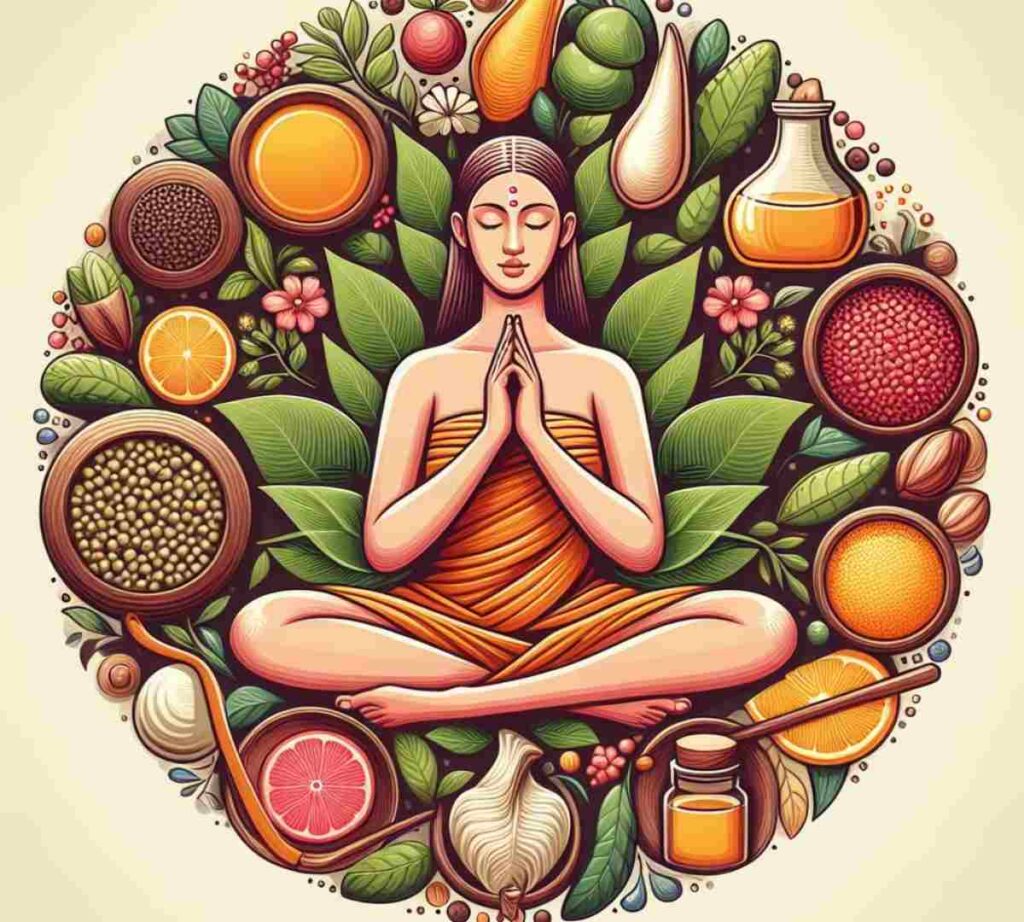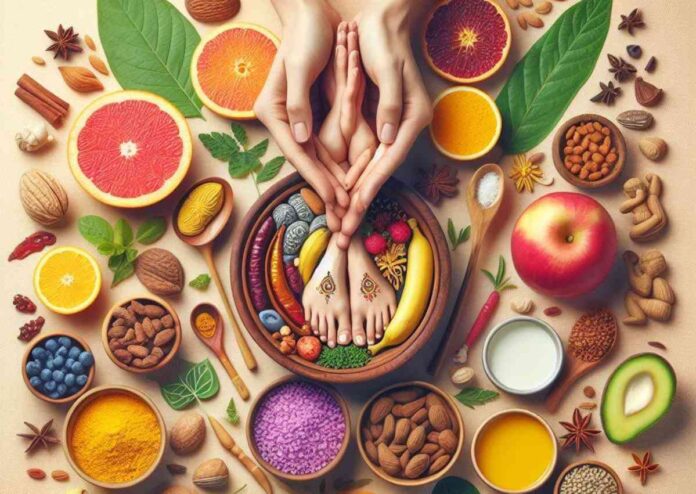Ayurveda, the ancient Indian life science, offers a treasure trove of wisdom for maintaining health and wellness. WellHealth’s Ayurvedic health tips provide a pathway to a balanced lifestyle through natural remedies, dietary adjustments, and daily routines tailored to individual needs.
Understanding Your Dosha
Doshas are the fundamental energies that govern physiological activity. Identifying your dominant Dosha—Vata, Pitta, or Kapha—is the first step toward personalized health.
- Vata governs movement and is light, dry, cold, irregular, and quick.
- Pitta regulates metabolism and is hot, sharp, liquid, slightly oily, and intense.
- Kapha governs structure and is heavy, slow, calm, oily, smooth, dense, soft, and stable.
Understanding your unique Dosha makeup allows you to create a lifestyle and wellness plan aligned with your constitution for optimal health and vitality.
Nourishing Your Body with Ayurveda

Ayurveda emphasizes nurturing your body with the proper nutrition to balance your Doshas. Here are some Ayurvedic superfoods and eating principles for radiant health.
Ayurvedic Superfoods
- Turmeric: A potent anti-inflammatory and antioxidant. It helps balance all three Doshas, especially Vata and Kapha.
- Ashwagandha: An adaptogenic herb renowned for its stress-reducing and calming properties. It is particularly beneficial for Vata imbalances.
- Triphala: A traditional formulation of three fruits that supports digestion and detoxification. Suitable for all Doshas, especially Pitta and Kapha.
- Ginger: A warming spice that kindles digestion and circulation. It helps pacify Vata and Kapha Doshas.
- Tulsi: Considered a sacred plant in India, tulsi is an antioxidant-rich adaptogenic herb that balances Vata and Kapha.
- Turmeric milk: A classic Ayurvedic elixir made with turmeric, milk, and warming spices like cinnamon and black pepper. It was grounding for Vata and cooling for Pitta.
- Chyawanprash: A nourishing jam-packed with over 50 herbs and spices. Traditionally used as a rejuvenating tonic and immunity booster. Balances Vata and Kapha.
Art of Eating According to Ayurveda
| Mealtime Practice | Benefits |
|---|---|
| Mindful Eating | Enhances digestion and satisfaction. |
| Warm Meals | Improve nutrient absorption. |
| Seasonal Foods | Aligns with Natural Bodies Rhythm. |
Ayurveda recommends:
- You are eating in a calm, pleasant environment without distractions. This improves digestion and allows you to tune into your body’s needs.
- They are prioritizing freshly cooked warm meals. Their nourishing qualities balance Vata.
- They are focusing on seasonal produce. In-season foods align with your body’s natural cycles.
- I am favoring home-cooked meals over processed food. Whole, natural ingredients nurture balance.
- I am avoiding iced drinks, which can shock the digestive system. Excellent or room-temperature beverages are preferred.
With mindful eating principles, you can transform mealtimes into a pillar of holistic wellbeing.
Enhancing Wellness Through Ayurvedic Practices

Ayurveda prescribes supportive daily routines and practices for nurturing body, mind, and spirit alignment.
Daily Routines for Balance
Establishing routines tuned to nature’s rhythms can profoundly enhance health and balance.
Morning: Rise before or at sunrise for optimal vitality. Start with meditation, light yoga poses, oil pulling, and tongue scraping. Drink warm lemon water. Apply sesame oil to feet. Enjoy a wholesome, nourishing breakfast.
Afternoon: Favor a light, easy-to-digest lunch. The largest meal is recommended in the early afternoon when digestion is vital. Walk after eating to aid digestion.
Evening:
- Have an early, light dinner.
- Wind down with calming activities like reading, gentle stretching, or oil massage before bedtime.
- Retire by 10 pm.
Bedtime: Apply sesame oil to feet and massage head and ears. Use aromatherapy oils like lavender.
Tuning your daily rhythm to nature’s cycles provides stability while honoring your body’s needs.
Power of Abhyanga: Ayurvedic Self-Massage
Abhyanga is self-massaging the entire body with warm herbalized oil before bathing. It promotes circulation, calms the nervous system, enhances skin health, and helps induce restful sleep.
Benefits of Abhyanga:
- Nourishes and rejuvenates the skin
- Stimulates lymphatic drainage
- Relieves fatigue and relaxes the body
- Enhances digestion
- Helps detoxify tissues
- Induces sound sleep
- increases your awareness of your physical body
Steps of Abhyanga:
- Warm organic sesame, almond, or herbal oil.
- Sit comfortably and begin massaging oil over your limbs and joints in long, gentle strokes. Apply light pressure with palms.
- Massage oil over the abdomen and chest with a clockwise, circular motion.
- Gently massage the head, ears, feet, and back of the neck.
- Allow oil to soak in for 5-20 minutes before bathing.
- Use a mild cleanser to remove excess oil after bathing.
Perform abhyanga 2-3 times per week for visible benefits. This profoundly nourishing practice harmonizes Vata dosha, promoting balance.
Ayurveda for Vata Dosha Wellbeing
Those with Vata as their dominant Dosha tend to have light, thin frames, dry skin, and quick movements. When balanced, Vata types are energetic, creative, and lively. Out of balance, they may experience anxiety, insomnia, digestive issues, and fatigue. To restore sattva and harmony to Vata, here are some Ayurvedic health tips:
Lifestyle:
- Maintain a calm, soothing, regular daily routine.
- Get sufficient rest and avoid staying up late.
- Limit exposure to cold, windy, or dry climates.
- Reduce stimulating activities and seek grounding practices.
- Practice meditation, gentle yoga, and breathing techniques to calm the mind.
Diet:
- Emphasize warm, nourishing, easy-to-digest foods cooked with oil and moisture.
- Include plenty of proteins, healthy fats, and cooked vegetables.
- Avoid cold, raw, or dry foods. Minimize beans, gas-producing veggies, and carbonated drinks.
- Favor sweet, sour, and salty tastes. Limit bitter, astringent, spicy foods.
- Enjoy warming spices like ginger, cumin, cinnamon, cardamom, and fennel.
- Stay hydrated with warm water, herbal teas, and warm nut milk.
- Nourishing foods: oats, rice, sweet potatoes, nuts, avocados, coconut, ghee.
Herbs and Supplements:
Ashwagandha, Shatavari, Brahmi, Tulsi, Triphala, and calming essential oils like lavender.
Practices: Abhyanga oil massage, yoga, pranayama, meditation, nature walks.
Tuning your lifestyle, diet, and routines to balance Vata brings stability, grounding, and a sense of calm wellbeing.
Balancing Pitta Dosha with Ayurveda
Pitta types have medium builds, fair skin, intense eyes, and quick intellects. In balance, they are driven, focused, and warm. Out of balance, Pittas may experience anger, criticism, infections, rashes, and digestive woes. Here are some Ayurvedic tips to soothe Pitta:
Lifestyle:
- Seek cooler climates. Avoid hot, humid environments.
- Practice relaxation techniques like yoga nidra to release stress.
- Engage in creative hobbies for emotional outlet.
- Reduce competitive, angry situations that overheat emotions.
- Take time outs when irritable or critical. Release frustration constructively.
Diet:
- Favor excellent, refreshing foods with high water content. Cucumber, melons, coconut water, leafy greens.
- Avoid hot, spicy, fermented, oily, acidic foods that aggravate Pitta, like chilies, vinegar, yogurt, and cheese.
- Reduce alcohol, tobacco, coffee, and other stimulants.
- Sweeteners like raw sugar and honey help balance Pitta. Reduce salt intake.
- Consume ample proteins like mung beans, chickpeas, chicken, and eggs.
- Coconut oil, olive oil, and ghee are good cooking oils for Pittas.
Herbs and Supplements:
Shatavari, Brahmi, manjistha, neem, fennel, coriander, licorice, mint.
Practices: Sheetali breathwork, moon salutations, swimming, nature walks in shady woods.
With a Pitta-soothing lifestyle and diet, you can harness your inner fire to spread warmth, joy, and passion to the world.
Bringing Kapha Dosha into Balance with Ayurveda

Kapha types naturally have solid, sturdy frames, lustrous hair, and tranquil dispositions. Balanced Kaphas are nurturing, supportive, and steady. Imbalanced Kaphas can become overweight, lethargic, possessive, and melancholy. Here are Ayurvedic tips to invigorate Kapha:
Lifestyle:
- Maintain an active, energetic routine. Avoid napping and sleeping excessively.
- Seek dry, sunny climates. Varied environments stimulate Kapha.
- Engage in active hobbies like hiking, cycling, and strength training.
- Spend time connecting with inspiring, positive people who energize you.
Diet:
- Favor light, drying, warming foods like beans, barley, bitter greens, honey.
- Minimize heavy, oily, cold foods like dairy, meat, nuts, and processed carbs.
- Reduce salt and sugar intake, which increases water retention.
- Spice meals with savory flavors like black pepper, chili, ginger, and mustard seeds.
- Stay hydrated with warm water, light herbal teas, and diluted fruit juices.
Herbs and supplements: Guggulu, bibhitaki, gotu kola, tulsi, pippali, cinnamon.
Practices: Vigorous exercise, pranayama, surya namaskar, dry brushing, alternating hot and cold showers.
With stimulant, light, and drying practices, Kaphas can keep their energy and motivation flowing freely while holding onto their serenity and compassion.
Herbalism and the Ayurvedic Pharmacy
Ayurveda offers a vast natural pharmacopeia of herbs and plants to prevent and treat health conditions, rejuvenate the body, and expand consciousness. Some essential herbs include:
- Ashwagandha: A rejuvenating adaptogen that enhances vitality, stamina, cognition, libido, and immunity. Balances Vata and Kapha.
- Brahmi: Known as a “brain tonic,” Brahmi improves memory, concentration, and intelligence and nourishes the nervous system. Soothes Vata and Pitta.
- Guggulu: An oleoresin with antioxidant, anti-inflammatory, and cholesterol-lowering actions. Traditionally used to treat arthritis and detoxify tissues. Balances Kapha and Vata.
- Manjistha: A lymph-cleansing herb that purifies blood, smoothes skin, and removes heat from the body. Pacifies Pitta Dosha.
- Neem: A bitter, cooling herb with potent blood and skin cleansing properties. Helps clear Pitta and Kapha accumulations.
- Shatavari: The herb “she who possesses 100 husbands” promotes fertility, vitality, and moisturization of the female reproductive system. Nourishes Vata and Pitta.
- Triphala: A famous Ayurvedic formula of three fruits that gently cleanses the colon, improves digestion and elimination, and removes toxins from the body. Balances all three Doshas.
Under the guidance of an Ayurvedic practitioner, herbal formulas can be crafted to precisely balance your unique constitution for healing and rejuvenation.
Value of Panchakarma for Rejuvenation and Detoxification
Panchakarma is a traditional Ayurvedic protocol for cleansing accumulated toxins from the body and restoring balance to the Doshas. Through preparatory practices, five cleansing actions, and therapeutic measures, impurities are removed, and health is renewed.
Pre-Panchakarma:
- Internal oleation with ghee or oils to loosen toxins
- External oil massage to mobilize impurities
- Heat therapies like saunas to open channels
- Mild laxatives or enemas may be used
Five Cleansing Actions of Panchakarma:
- Vamana: Therapeutic vomiting to apparent Kapha disorders
- Virechana: Purgation using herbs like senna to eliminate Pitta imbalances
- Basti: Medicated enemas to flush Vata disturbances from the colon
- Nasya: Nasal administration of oils to purify sinus congestion
- Rakta moksha: Blood-letting to remove toxins from the blood
Post-Panchakarma Care:
- Light, easy-to-digest meals are consumed
- Rest is emphasized while the body rebalances
- Yoga, meditation, and self-care are important
- Herbal formulas may be provided for continued healing
When performed by a qualified Ayurvedic practitioner, Panchakarma offers deep cleansing at a cellular level, resulting in a renewal of health and wellbeing.
Achieving Balance Through Marma Therapy
Marmas are vital energy points in the body, similar to acupressure points in Chinese medicine. Optimal health and inner balance arise through marma point massage, injury prevention, and activation.
Benefits of Marma Therapy:
- Balances circulation
- Releases muscular knots and tension
- Calms the nervous system
- Improves lymphatic flow
- Enhances vitality and cognition
- Corrects energy imbalances
- Promotes faster healing from injuries
Marma Massage Approach
- Use gentle, loving touch around marmas
- Pour small streams of warm oil over points
- Slowly massage marma regions in circles
- Apply mild pressure with fingertips
- Stimulate both sides of the body for symmetry
Precautions:
- Avoid marma therapy during pregnancy
- Apply less pressure on sensitive points
Activating your marma points facilitates the optimal flow of prana, instilling harmony between body and mind. Consult an Ayurvedic practitioner to learn the ideal marma therapy regimen for your unique needs.
Integrative Ayurvedic Approaches for Modern Health Concerns

Ayurveda’s timeless wisdom provides a holistic toolkit to address many modern health conditions. Integrative Ayurvedic protocols emphasize natural herbs, oils, diets, detoxification, yoga therapy, sound healing, meditation, pranayama, and lifestyle changes tailored to each person’s constitution and imbalances.
- For Anxiety and Depression: Adaptogenic herbs like Ashwagandha, Brahmi, and Tulsi, breathwork like alternate nostril breathing, calming yoga poses, meditation, Panchakarma, Abhyanga massage, and cognitive reframing therapy.
- For Type 2 Diabetes: Bitter melon, cinnamon, fenugreek, aloe vera, curcumin, meal planning per Dosha, gentle yoga for circulation, Panchakarma for toxin removal, stress management.
- For Pain Management: Anti-inflammatory spices like turmeric, Boswellia, ginger, Guduchi, gentle yoga therapy, oil massage, heat/cold therapy, lifestyle changes, and careful herb use for pain relief.
- For Autoimmune Conditions: Immune modulating herbs like Ashwagandha, Tulsi, and Guduchi, elimination diets, digestion strengthening, Panchakarma, identifying and removing triggers, and managing stress.
- For Skin Conditions: Herbs and oils for blood purification, avoidance of pitta-aggravating foods, topical treatments, Panchakarma, internal oleation, lymphatic drainage support.
For Cancer Support:
- Immunomodulating and adaptogenic herbs like Ashwagandha, Tulsi, and Curcumin support the body’s natural defenses.
- Anti-inflammatory spices like Turmeric and Ginger to reduce inflammation.
- Detoxifying herbs and cleansing protocols like Panchakarma to remove toxins.
- Antioxidant-rich diet of colorful fruits, vegetables, and spices to limit oxidative damage.
- Gentle, restorative yoga poses and pranayama to reduce stress and nurture body-mind recovery.
- Meditation and mindfulness to ground emotions and nourish peace.
- Emotional support systems and counseling for mental health.
- Palliative herbs like cannabis for pain relief when appropriate.
Ayurveda aims to holistically support strength, vitality, and comfort during the cancer journey with natural medicines, a healing lifestyle, emotional support, and spiritual nourishment.
For Menopause Support:
- Cooling foods and herbs like Shatavari, Ashoka, and Brahmi to balance hormonal swings.
- Yoga asanas to stimulate estrogen production and manage hot flashes.
- Massage with cooling oils to balance Pitta and Vata.
- Meditation and counseling for emotional health.
- Vaginal herbal oils and moisturizing Kegel herbs for comfort.
- Adaptogenic herbs like Ashwagandha to manage stress and fatigue.
- Estrogen-balancing, bone-supporting herbs like Shatavari.
- A healthy, nutritious diet tailored to Dosha balance.
Ayurveda offers a holistic toolkit to ease the menopausal transition and support women’s vitality with natural solutions.
For Healthy Aging and Longevity:
- Rasayanas – Herbs and foods like Amla that provide rejuvenation.
- Gentle yoga poses and pranayama to nurture joints, flexibility, circulation, and oxygenation.
- Massage for lymphatic and circulatory health.
- Stress management through meditation.
- Brain tonics like Brahmi for memory and cognition.
- Supporting microbiome diversity through prebiotics and probiotics.
- Antioxidant-rich nutrition to limit free radical damage.
- Positive social connections for emotional health.
- Panchakarma and detox routines annually.
Ayurveda provides holistic tools to foster inner youth, strength, and renewal throughout life’s journey.
For Inflammation:
- Anti-inflammatory herbs and spices like turmeric, ginger, Boswellia, Ashwagandha, and Tulsi.
- Avoid inflammatory foods like refined carbs, sugars, and processed oils.
- An anti-inflammatory diet rich in omega-3s, colorful fruits/veggies, and green tea.
- Body cleansing through Panchakarma.
- Stress reduction techniques.
- Gentle, restorative yoga and pranayama.
- Topical use of herbal oils like Kirundi and mahanarayan for joint pain.
For Thyroid Health:
- Adaptogens like Ashwagandha, holy basil, and Guggulu balance hormones.
- Detoxification through Panchakarma to remove ama.
- Kelp, iodine-rich foods to nourish thyroid function.
- Yoga for Shoulders, Fish pose, and Sarvangasana to stimulate the thyroid.
- Pranayama is like Bhramari breathing.
- Herbs like Coleus forskohlii, guggulu, kanchanar guggulu.
For Fatigue/Low Energy:
- Adaptogens like Ashwagandha, Guduchi, and Shilajit increase vitality.
- Blood cleansing herbs like Manjistha.
- Yoga asanas and pranayama to improve oxygenation.
- Balanced meals for stable blood sugar.
- Panchakarma for detoxification.
- Lifestyle changes to reduce stressors and improve sleep.
For Healthy Weight Loss:
- Guggulu, Triphala, and cinnamon support metabolism and fat burning.
- Yoga to build lean muscle mass and burn calories.
- Cardiovascular exercise tailored to Dosha.
- Low glycemic index diet based on Ayurvedic principles.
- Herbs like garcinia cambogia regulate appetite.
- Panchakarma to remove toxins and stagnation.
- Coaching on mindful eating habits.
The holistic healing system of Ayurveda offers natural, integrative solutions tailored to each person’s constitution and imbalances to foster optimal wellbeing and address various modern health challenges.
For Brain Health and Memory:
- Brain tonics like Brahmi, Ashwagandha, and Jatamansi nourish neurons and cognition.
- Head massage with medicated Ayurvedic oils.
- Memory-enhancing foods like nuts, berries, and avocados.
- Meditation, yoga, and breathing exercises to maximize oxygen supply.
- Learning new skills and intellectual stimulation.
- Managing stress levels with relaxing activities.
- Getting sufficient sleep for brain restoration.
- Panchakarma to remove toxins impacting neuronal function.
For Healthy Sleep:
- Calming nightly rituals like oil massage and warm baths.
- Sleep-inducing herbs like nutmeg, valerian, and chamomile.
- Avoiding stimulants like coffee and electronics before bed.
- Yoga poses and pranayama to reduce anxiety and restlessness.
- Meditation and mindfulness for relaxation.
- Managing the circadian rhythm by going to bed early.
- Creating an ideal sleep environment – calm, dark, and quiet.
For Strengthening Immunity:
- Immunomodulators like Ashwagandha, Guduchi, Tulsi, and Amalaki.
- Supporting micronutrients like Zinc, Vitamin C, and Vitamin D.
- Elimination diets to identify food sensitivities.
- Probiotic-rich foods for gut health.
- Managing stress through yoga and meditation.
- Good sleep, exercise, and hygiene habits.
- Panchakarma therapy to cleanse the body of toxins.
For Healthy Digestion:
- Bitter herbs like Trikatu to improve Agni.
- Carminatives such as fennel, ginger, and mint to reduce bloating.
- Demulcents like Psyllium husk to soothe intestinal irritation.
- Probiotic foods to balance the gut microbiome.
- Avoiding incompatible food combinations.
- Eating as per Agni and in a peaceful environment.
- Abdominal massage and yoga twists to stimulate digestion.
- Triphala and other cleansing herbs.
The holistic system of Ayurveda empowers you to cultivate balance, heal imbalances, and nurture total wellbeing with time-tested natural solutions tailored to your unique mind-body needs.
Concluding Lines
The timeless wisdom of Ayurveda provides an invaluable guidemap for cultivating balance and wellbeing amidst the stresses of modern life. By tuning into your body’s natural rhythms, adopting wholesome routines, and making supporting lifestyle adjustments, Ayurvedic health tips help you actualize your fullest potential with vibrant health. Whether through using medicinal herbs, practicing oil massage, or simply eating according to your Dosha, small steps towards integrating Ayurveda can yield profound healing benefits. This holistic science to unlock your journey towards inner harmony and optimal wellness.


